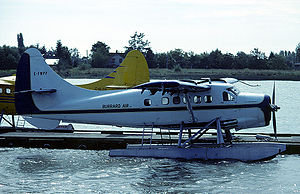The De Havilland DHC-3 Otter: From Bush Plane Classic to 21st Century Workhorse
When the de Havilland DHC-2 Beaver became a legend in bush flying, the Canadian manufacturer knew it could go bigger. In 1951, the first DHC-3 Otter took flight—a stretched, more powerful “King Beaver” designed to carry heavier loads into and out of the most unforgiving places on Earth.
Between 1951 and 1967, just 466 Otters were built. But in those years, the aircraft established itself as a rugged, versatile platform equally at home on floats, skis, or wheels. Its short takeoff and landing (STOL) performance allowed it to service remote communities, carry freight, and support military operations across the globe.
Even in its earliest days, the Otter proved itself on extraordinary missions: one supported the first overland crossing of Antarctica in 1957. Others flew search and rescue for the Royal Canadian Air Force or ferried supplies in Southeast Asia.
Built for the Bush
The Otter was engineered to take the Beaver’s winning formula and scale it up. A lengthened fuselage, larger wing, and a 600 hp Pratt & Whitney R-1340 Wasp radial engine gave it more power and more payload capacity. Operators quickly embraced its ability to haul 10–11 passengers or over 2,000 lbs of cargo into short or unimproved airstrips.
For bush pilots in Canada, Alaska, and other remote regions, the Otter became a lifeline. It offered capacity without sacrificing rugged reliability—qualities that explain why so many still fly today.
The Turbine Era
By the 1980s and 1990s, the Otter’s radial engines were showing their age. Operators wanted more efficiency, reliability, and parts support. The solution? Turbine conversions.
- Vazar Turbine Otter: Swaps the radial for a Pratt & Whitney PT6A-135 turboprop, instantly recognizable with its long, pointed nose.
- Texas Turbine Super Otter: A higher-powered variant also using a PT6.
- Soloy Dual Pac Testbed: An experimental Otter fitted with two PT6s driving a single propeller.
- Airtech Canada DHC-3/1000: Features a Soviet-designed ASz-62IR radial conversion.
Most recently, Viking Air, which acquired type certificates for de Havilland aircraft, has certified its own DHC-3T Turbine Otter, extending the Otter’s service life well into the 21st century.
Where Otters Fly Today
Despite being out of production for nearly 60 years, the Otter remains a workhorse in some of the world’s most demanding environments:
- Harbour Air (Vancouver, BC): Operates more than 20 Otters, mostly floatplanes, as part of its busy commuter and sightseeing fleet.
- Superior Airways (Ontario): Flies turbine-converted Otters, including both PT6 and Walter GE-powered examples.
- Wings Airways (Alaska): Preserves the Otter’s heritage by overhauling aircraft to near-new condition with turbine upgrades, glass cockpits, and modern interiors.
In Alaska, Canada, and parts of Africa, the Otter is still an essential connection for communities far from paved roads and highways.
Why the Otter Endures
The Otter’s survival into 2025 is no accident. A combination of solid design, adaptability, and ongoing modernization has kept it relevant long after many contemporaries have disappeared. Operators prize its:
- Payload capacity compared to the smaller Beaver.
- STOL performance in rugged terrain.
- Flexibility for floats, skis, and wheels.
- Longevity thanks to turbine conversions.
The fact that Viking Air still supports the type—and that dozens remain in frontline service—speaks volumes about its enduring utility.
The DHC-3 Otter: A Living Legacy
The DHC-3 Otter is more than a historical artifact; it’s a living reminder of aviation’s golden age of rugged design. In a world of composite airliners and advanced avionics, the Otter continues to prove that simple, sturdy engineering never goes out of style.
From ferrying tourists over Alaskan glaciers to serving remote fishing lodges in northern Canada, the Otter’s story is still being written. What began as the “King Beaver” has become a king of endurance, a bush plane that refuses to fade into history.
